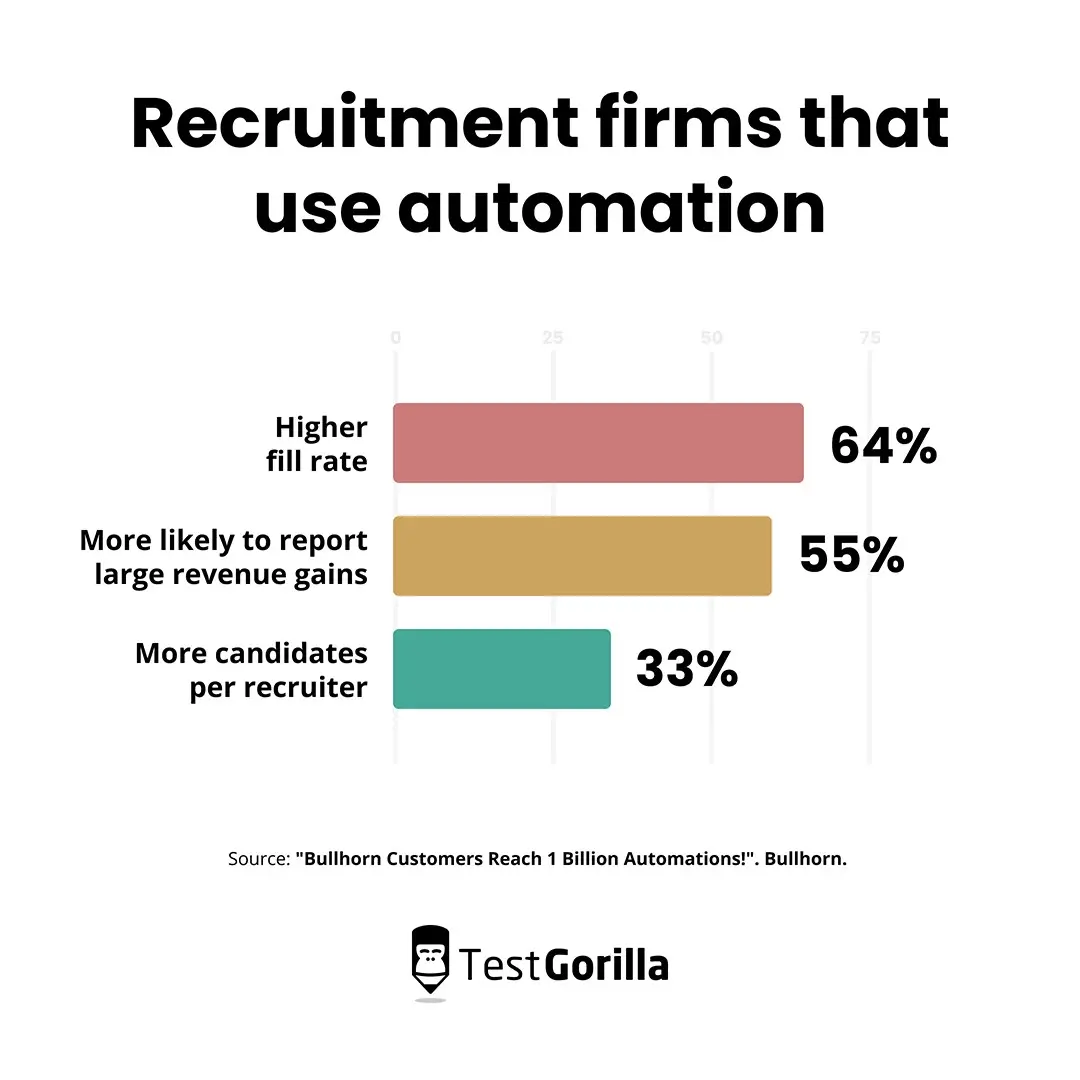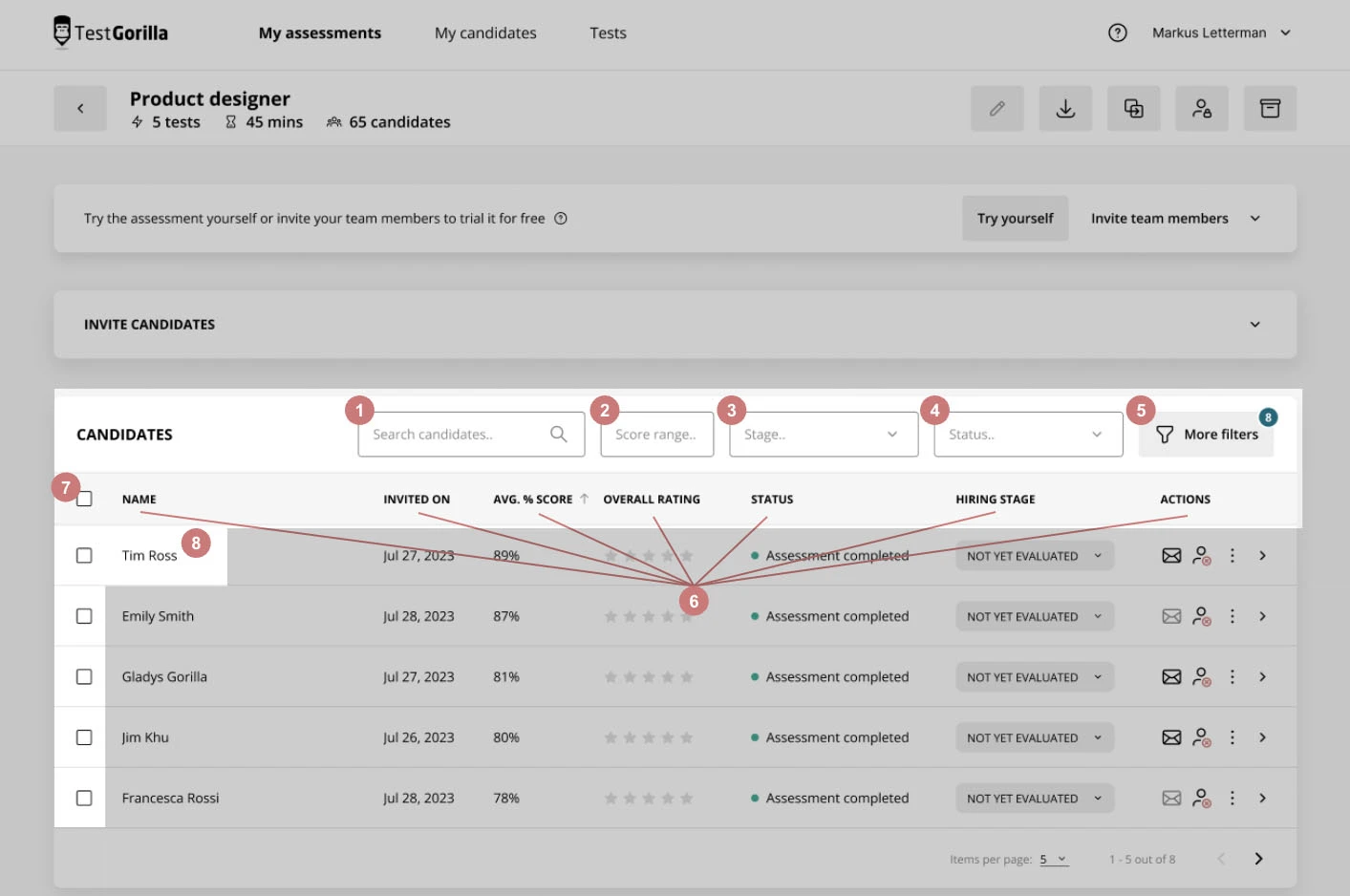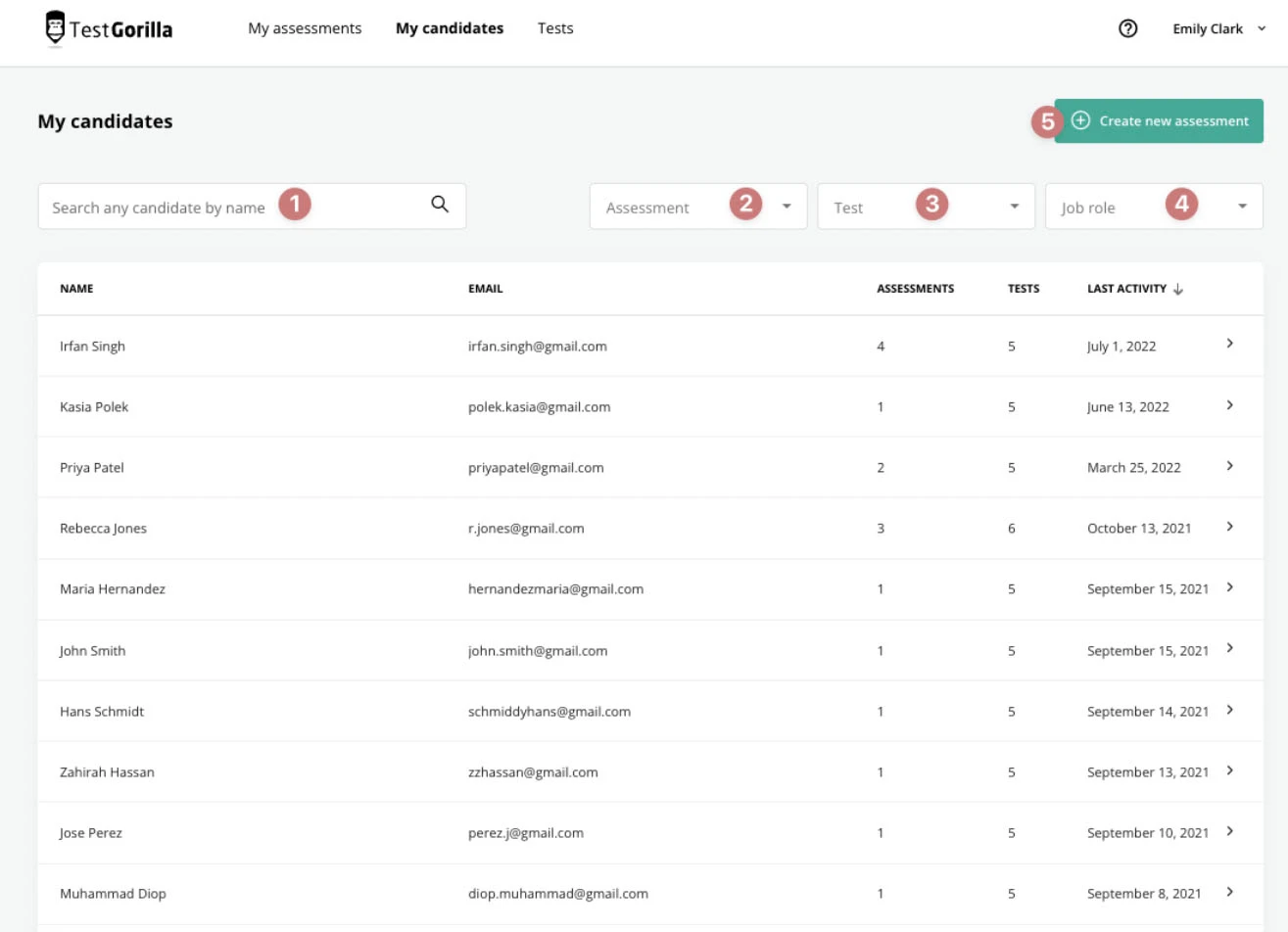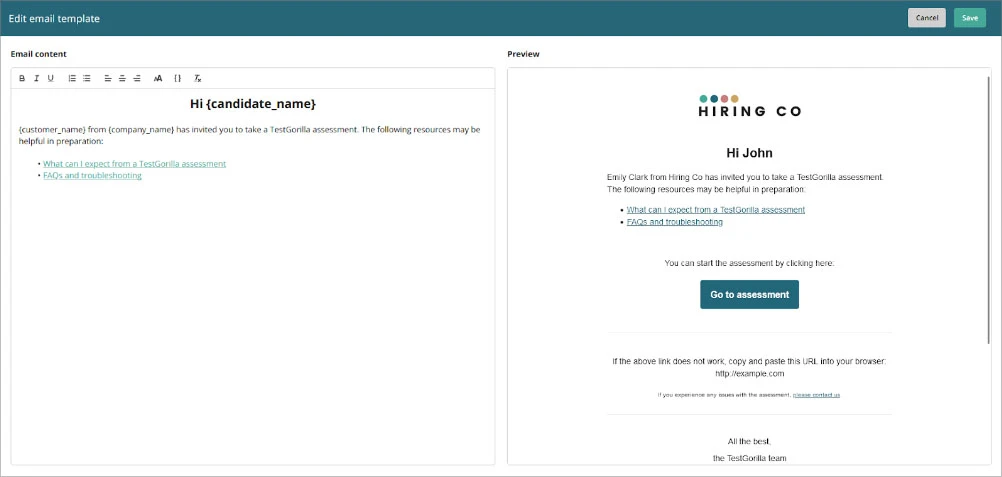Recruiting automation: How to leverage this talent acquisition trend to save time and engage candidates
Recruiters face a lot of challenges nowadays.
In an average week, you could find yourself juggling hundreds of candidates to combat a skills shortage – and still trying to put a compassionate human touch into your work.
It doesn’t sound possible, at least without going into employee burnout.
So what’s the solution?
Recruiting automation.
This talent acquisition trend doesn’t just keep you sane by giving you real-time answers to recruiting issues; it also improves candidate quality and time-to-hire and helps you manage your time better.
Recruitment automation tools can:
Post job ads for open roles
Assist passive recruiting by sourcing and nurturing candidates
Zero in on real skill and reduce bias
This article discusses the importance of using recruiting automation in your hiring process and our best practices for getting the most out of your recruitment automation tools.
Table of contents
- What is recruiting automation?
- Why is recruitment automation important?
- The benefits of recruitment automation
- The 8 best practices for leveraging recruitment automation tools to acquire top talent
- Recruiting automation: 3 examples of companies succeeding with this talent acquisition trend
- Reduce bias and improve candidate quality with recruiting automation
- Sources
What is recruiting automation?
Recruiting automation is a technology that helps organizations automate hiring tasks or HR activities that take much of the recruiter’s time.
These tasks may include creating job postings, sourcing candidates, evaluating their skills, and conducting interviews.
Examples include automating responses to applicants so the hiring manager doesn’t need to personally respond to dozens of messages.
Recruitment automation software is a great tool to integrate into your talent acquisition strategy.
It helps improve the candidate experience and gives the recruiter more time to focus on tasks that require a human touch, such as writing inclusive job descriptions or personally responding to high-priority candidates.
What are different examples of recruitment automation software?
Automated talent acquisition technology comes in many varieties, each providing unique value to your hiring process.
Here are a few of the most common types:
Candidate sourcing
Candidate screening and experience
Talent assessment tests
Candidate relationship management and recruitment marketing
Applicant tracking systems
Interviewing and interview scheduling
These recruitment tools let you automate recruitment process tasks from start to finish, from candidate sourcing to managing interviews.
This large variety of tech enables you to highly personalize your hiring process and automate what you need because every HR department is different.
Automated recruiting vs. AI
Let’s quickly clear up the difference between automated recruiting and artificial intelligence: Automation isn’t artificial intelligence (AI) or machine learning.
Automation runs on preprogrammed rules, meaning your recruiting teams directly control what your recruitment automation tools do.
An example is programming your software to send all interested candidates a “thank you” message.
On the other hand, you can program AI to artificially think like a human and make decisions.
An example could be using an AI chatbot to give a candidate an answer it believes the candidate needs to know.
Recruiting automation software is less risky than AI and less prone to bias. However, with careful consideration, you can still use AI in hiring.
Read our blog on AI in talent acquisition for more on this topic.
Why is recruitment automation important?
Recruitment automation is gaining traction quickly in the hiring world and is one of the biggest recent recruiting trends.
Technological advancements have made recruiting automation software easier to access, more affordable, and more effective than ever.
More recruiters turn to this tech to assist their work, make the hiring process smoother, and eliminate manual tasks.
The driving factors behind recruiting automation include low unemployment and a large skills shortage.
Many organizations invest in recruiting tech to improve their chances of securing great talent.
Companies are competing to get the best talent first, and one of the best ways to do that is to improve your hiring process.
Recent research has shown that recruitment firms that use automation have a 64% higher fill rate, submit 33% more candidates per recruiter, and are 55% more likely to report large revenue gains.[1]
Let’s dig deeper into why recruitment automation tools are important to employers.
Save recruiter time: Recruiters have many tasks to complete, from background checks to follow-ups. It’s already an overload, but when you factor in the candidates’ skills, it’s nearly impossible to complete without automation.
Optimize hiring speed and efficiency: Recruiting automation boosts hiring efficiency tenfold, automating tedious tasks and enabling recruiters to fill open positions faster.
Free up recruiter time for things that need a human touch: The hiring process always needs a human touch, and recruiting automation frees up extra time to put care and consideration into your interview process.
Automated recruitment tools also benefit the candidates in the hiring process.
Provide a better experience with more communication: Candidates need good communication, and automated recruiting assists with automatic responses and frees up HR managers to personally respond to high-priority candidates.
Reduce bias and help create a fair experience: Most recruiting automation software helps hiring managers focus on skills instead of age, gender, race, and orientation, reducing overall bias.
The benefits of recruitment automation
Recruiting automation brings many benefits to your hiring process, including easier scalability and improved time-to-hire.
These advantages result in a strong return on investment (ROI) and are key to getting buy-in from decision-makers.
Let’s explore five key benefits of recruiting automation.
Improves time-to-hire
Automated recruiting speeds up your hiring process so you can fill roles faster and more efficiently.
Want to know how much faster? Let’s do a little math.
As of December 2022, filling an open role takes an average of 11 weeks, up from seven weeks in 2021.
And according to research by Entelo, recruiting automation software can reduce time-to-hire by seven to 15 percent.[2]
You can decrease time-to-fill by five to 11 days per role, reducing recruiting costs because every day a role is unfilled, it costs the company money.
For more information, read our cost-per-hire guide for HR professionals.
Improves scalability
When you automate recruitment process tasks, it makes it easier to scale your business and eliminate repetitive tasks.
A larger company means more applicants, and your current hiring plan may not be ready. You don’t want your team to suddenly be neck-deep in work they can’t handle.
Recruiting automation also helps source, sort, and assess large numbers of potential candidates.
To read more, check out our blog post on high volume hiring.
Helps great candidates from slipping through the cracks
It’s a shame when a hectic hiring process causes a great candidate to get lost in the mess. It’s even worse when you don’t know how often this happens.
Recruitment automation helps solve this in several ways:
Maintains candidate engagement
Reminds recruiters to keep an eye on high-quality candidates
Helps sort through hundreds of applicants to find the best
This way, the ideal candidate for the position isn’t lost in the sea of applicants.
When you evaluate candidates with skills tests, you can even shortlist applicants by the most qualified.
But we touch on that more later.
Boosts productivity and performance
When recruiters aren’t busy with tedious tasks, they can focus on what’s important.
With more time on their hands, recruiters can dedicate themselves to writing job descriptions, crafting structured interviews, and working personally with hiring stakeholders to make crucial hiring decisions.
Freeing up recruiters’ time improves your hiring and work processes and enables you to perform better and scale faster.
Improves candidate experience
A negative candidate experience can damage your reputation, but a great one improves your employer branding and attracts top talent.
Candidates need a good experience from start to finish, and recruiting automation enables you to keep consistent communication, respond promptly, and gauge candidates’ skills fairly.
For more insights, read our full guide on the candidate experience.
The 8 best practices for leveraging recruitment automation tools to acquire top talent
Recruiting automation software can save a company time, money, and effort.
However, that doesn’t mean it’s as simple as buying the software and hitting “go.”
Here are our top strategies for using recruitment automation tools to their full potential.
Strategies for using recruiting automation: A summary
Best practices | Description |
Prescreen candidates with skills tests to find the ideal employee | Find quality candidates quickly and efficiently by assessing skills with talent assessments Don’t let highly qualified candidates slip through the cracks by sorting them by test scores |
Use recruitment automation tools to reduce bias | Use skills tests to reduce hiring bias and focus on skills and competencies |
Use automation to streamline interviews | Enable candidates to schedule interviews in your calendar quickly and easily Send reminders to interviewers and interviewees |
Use the extra time you gained to apply the human touch | Automate admin tasks so HR can devote more time to improving the hiring process and nurturing top talent |
Personalize templates to engage candidates | Customize your automated templates to add personality to correspondence |
Automate shortlisting and rejection | Ensure candidates get a professional rejection and aren’t left hanging |
Leverage different types of recruitment automation software | Use a variety of recruitment automation tools to streamline different parts of the hiring process |
Combine it with recruitment marketing to reach the right audience | Ensure you post your job listings in the right time frame and place to engage your ideal candidates |
1. Prescreen candidates with skills tests to find the ideal candidate
Talent assessment tests are a type of automated recruitment that help you find the best candidate for the role quickly and effectively.
Far too many great candidates slip through the cracks during the hiring process.
Skills tests enable you to objectively assess candidate skills and capabilities and sort applicants by their best scores.
Here’s how you sort candidates with TestGorilla:
After candidates finish their talent assessments, you can see the applicants and their average scores on your dashboard. You can now use filters to sort candidates by:
Minimum and maximum score
Stage, such as “Take-home test completed” or “Interviewed”
Test status
A certain test score range
Answers to specific questions
We talk about this in-depth in our guide to analyzing results.
This process enables you to quickly sort the best candidates and scrutinize them closely.
In traditional hiring, if certain candidates got buried in your email, you didn’t get to review them – no matter how good they were.
We can easily, objectively hire people because of automation technology.
Resumes used to be our best option because they were our only option.
For more insights, read our blog on how technology enables the rise of skills-based hiring.
2. Use recruitment automation tools to reduce bias
Recruitment automation software can reduce bias and zero in on real human skills.
When discussing automation, many people immediately think of the biases associated with AI. There’s a big difference between automation and AI, and automated recruiting can reduce unconscious bias and lead to fairer hiring.
Automation helps recruiters focus on skills and behavioral competencies rather than age, gender, race, or work history.
For example, evaluating an applicant with a talent assessment ranks candidates based on their scores.
This way, all high-quality candidates are at the top, leaving out the unqualified candidates. The recruiter can focus on real capabilities without being distracted by inherent human biases.
For more information about how skills-based hiring can help, check out our blog on reducing bias.
3. Use automation to streamline interviews
Automation tools enable you to automate interview scheduling, easing the burden on the admin work of recruiters.
Recruitment automation software can send out calendar invites and schedule interviews.
These tools also help by automating interview reminders for employers and employees, decreasing no-shows.
This process improves the candidate experience by enabling them to quickly schedule interviews at the most convenient time.
Reminders also improve this experience by enabling candidates to prepare and manage their anxiety.
Streamlining interviews sends a powerful message to your candidates that your company is eager and excited to speak to them about this opportunity.
4. Use the extra time you gained to apply the human touch
Hiring always requires a human touch in some regard, and automating tedious parts of the process enables recruiters to put their heart and soul into what needs it.
When recruiters aren’t busy digging through emails and scheduling interviews, it frees up important time for other tasks such as:
Writing inclusive job descriptions
Interviewing and gauging a candidate’s soft skills and personality
Analyzing and improving the hiring process
Crafting effective interview scripts
Nurturing candidates who are high-priority, such as those who have been through one or two interviews
Technology can do a lot, but it can’t replace the care and compassion HR professionals put into their work.
Let’s use it for what it’s best at, so you can do what you’re best at.
If you’d like to know more about keeping the “human” in “human resources,” read our blog on how to automate recruitment.
5. Personalize templates to engage candidates
Candidates like to see a little personality and customization in the hiring process – no one wants to see messages like “Thank you, Candidate.”
Automation requires the use of a lot of preprogrammed templates, but that doesn’t mean you can’t personalize them.
Here’s how you can personalize your automated recruiting with TestGorilla:
TestGorilla lets you customize candidate communications, such as invitations, candidate results pages, and rejection letters.
You can include the candidate’s name, your company name, your company’s color scheme and logo, and even your brand voice.
A touch of personality tells the candidate that robots don’t run your company. Instead, real people excited to take the next steps are in charge.
6. Automate shortlisting and rejection
Rejection is a crucial part of the candidate experience. Job seekers want to hear when the answer is “no,” but many don’t get to.
A survey from Indeed found that 44% of candidates wait at least two weeks to hear back from an employer during the hiring process, and at least 15% wait months.[3]
Automated recruiting makes it quick and easy to tell rejected candidates they won’t be going further in the process, giving them closure and enabling them to continue their job hunt.
Candidates make note of companies that take the time to tell them “no.” They’re more likely to speak positively about you and try out for another position in the future.
However, we recommend writing out personal rejection letters to candidates who have gone through an interview or more.
Automated rejection letters are fine for candidates early in the process, but when a person has dedicated a lot of time to it, you should show respect with a human-created email.
To help this process, use our candidate rejection email template.
7. Leverage different types of recruitment automation software
There are dozens of different types of recruitment automation tools to improve a variety of HR functions.
Depending on your company, you can mix and match different ones to achieve your goals.
Here are a few of our top recommendations:
Talent assessment software: Talent assessments gauge candidates’ skills and lead to fewer mis-hires, higher diversity, and reduced costs
Internal talent marketplace: A database of open positions and employee skills boosts your company’s internal mobility and leads to increased satisfaction
Employee referral software: Automated referrals make it simple for employees to quickly share opportunities with their networks and grow your employee referral program
Candidate relationship management software: Software that automates candidate-relationship-building tasks and keeps information organized
8. Combine it with recruitment marketing to reach the right audience
Recruitment marketing is similar to regular marketing, but instead of promoting products, it promotes your employer brand, company culture, and open roles.
It’s an excellent strategy for reaching a wider audience and the right candidates. Combine it with automation, and you can post your job ads on the right job boards at the perfect time.
Automation can also help with your recruitment email marketing or social media recruiting, which are important parts of recruitment marketing.
Recruitment email marketing is a low-cost tactic that nurtures high-quality candidates by connecting with them on a personal level.
Recruiting automation: 3 examples of companies succeeding with this talent acquisition trend
Now, let’s look at a few organizations that have adopted recruiting automation software and seen amazing results in the quality of hire as a result.
Companies that successfully use recruiting automation: A summary
Organizations | Description |
Kuehne+Nagel | A transport and logistics company that increased its internal hires and decreased time-to-fill |
The Network | A global IT recruitment agency that improved its data entry and boosted visibility into the hiring process |
Revolut | A financial services company that used language tests to reduce time-to-hire by 40% |
1. Kuehne+Nagel
Kuehne+Nagel, a global transport and logistics company, used an automated internal talent marketplace to boost internal mobility.[4]
This strategy enabled it to quickly and easily source new hires from its workforce and nurture career growth opportunities for its people.
Kuehne+Nagel used this marketplace to create an employee portal to increase the number of internal hires, boost employee engagement and retention, and reduce time-to-hire.
Here’s what it achieved in only two and a half months:
13% conversion rate for internal candidates sourced through the marketplace
22% conversion rate for internal candidates overall
20% decrease in time-to-full for internal requisitions
2. The Network
The Network, a global IT recruitment agency, adopted recruitment automation software to boost old processes that needed an update.
The old systems had basic functionality, but it became apparent that they were outdated and needed recruitment automation technology to hire top candidates.
The company adopted an applicant tracking system (ATS) and a candidate relationship management system (CRM) to solve this.
Its recruiters quickly took to these new systems and made some impressive improvements in the hiring process:
Significantly reduced data entry time
Achieved more workflow visibility with data driven recruiting, which improved management
Facilitated scaling plans
3. Revolut
Revolut, a British-Lithuanian financial services company, improved its time-to-hire by streamlining its language testing process.
As a European company, the firm assesses hundreds of candidates on language ability to ensure qualified proficiency. But this process is usually time-consuming, tedious, and prone to human error.
The company solved this by adopting TestGorilla’s skills tests to accurately and quickly evaluate its candidates’ language proficiency.
Automating this process improved Revolut’s time-to-hire by an impressive 40%.
Julia Panchenko, the firm’s services recruitment manager, said this about the results:
“We believe that TestGorilla is helping us to speed up hiring for language-support roles, evaluate candidates more objectively, and hire more efficiently.”
For more insights, read the whole story.
Reduce bias and improve candidate quality with recruiting automation
Recruiting automation is a solid tactic for your hiring toolbox, metrics, and integrations. It improves time-to-hire, facilitates internal mobility, and helps your company scale more efficiently.
And with all the extra time it gains, your HR department can focus on the human side of hiring.
Use best practices like skills tests, automated shortlisting, and recruitment marketing to take your automated recruitment to the next level
If you’re ready to learn more about that last point, head over to our full guide about recruitment marketing.
To scale your HR team and improve your recruiting process and talent pool, use our Talent Acquisition test to gauge sourcing, onboarding, and recruitment analytics skills.
Sources
"Bullhorn Customers Reach 1 Billion Automations!". Bullhorn. Retrieved August 3, 2023. https://www.bullhorn.com/1-billion-automations/
"What is Recruiting Automation?". Entelo. Retrieved July 28, 2023. https://www.entelo.com/recruiting-automation
"How to Write Job Rejection Emails (With Template & Samples)". Indeed. Retrieved July 28, 2023. https://www.indeed.com/hire/c/info/how-to-write-a-candidate-rejection-email
"How Kuehne+Nagel Empowers Employees To Own and Grow Their Careers". Phenom. Retrieved July 28, 2023. https://www.phenom.com/resource/how-kuehne-nagel-is-empowering-employees-to-grow-their-careers
Related posts
Hire the best candidates with TestGorilla
Create pre-employment assessments in minutes to screen candidates, save time, and hire the best talent.
Latest posts
The best advice in pre-employment testing, in your inbox.
No spam. Unsubscribe at any time.

Hire the best. No bias. No stress.
Our screening tests identify the best candidates and make your hiring decisions faster, easier, and bias-free.
Free resources
This checklist covers key features you should look for when choosing a skills testing platform
This resource will help you develop an onboarding checklist for new hires.
How to assess your candidates' attention to detail.
Learn how to get human resources certified through HRCI or SHRM.
Learn how you can improve the level of talent at your company.
Learn how CapitalT reduced hiring bias with online skills assessments.
Learn how to make the resume process more efficient and more effective.
Improve your hiring strategy with these 7 critical recruitment metrics.
Learn how Sukhi decreased time spent reviewing resumes by 83%!
Hire more efficiently with these hacks that 99% of recruiters aren't using.
Make a business case for diversity and inclusion initiatives with this data.





















